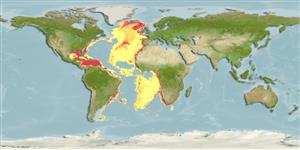Environment: milieu / climate zone / depth range / distribution range
Ecología
marino batipelágico; rango de profundidad 550 - 1600 m (Ref. 4448). Deep-water
Eastern Atlantic: Western Sahara to Mauritania, and the Canary Islands. Western Atlantic: New York, USA to Venezuela, including the Gulf of Mexico and the Caribbean. Reported off the Guianas (Ref. 13608).
Tamaño / Peso / Age
Maturity: Lm ? range ? - ? cm
Max length : 60.0 cm TL macho / no sexado; (Ref. 4448)
Scales present on the dorsal surface of the head and one lateral line scale for each myotome. Grayish white with a dark brown checkerboard or net like pattern formed by dark spots on each scale pocket (Ref. 37108).
Inhabits bathyal depths. Feeds on small crustaceans, annelids, mollusks and echinoderms (Ref. 4448).
Life cycle and mating behavior
Madurez | Reproducción | Puesta | Huevos | Fecundidad | Larva
Sulak, K.J., 1990. Halosauridae. p. 126-132. In J.C. Quero, J.C. Hureau, C. Karrer, A. Post and L. Saldanha (eds.) Check-list of the fishes of the eastern tropical Atlantic (CLOFETA). JNICT, Lisbon; SEI, Paris; and UNESCO, Paris. Vol. 1. (Ref. 4448)
IUCN Red List Status (Ref. 130435)
Threat to humans
Harmless
Human uses
Más información
Nombres comunesSinónimosMetabolismoDespredadoresEcotoxicologíaReproducciónMadurezPuestaAgregación para la puestaFecundidadHuevosEgg development
ReferenciasAcuiculturaPerfil de acuiculturaRazasGenéticaElectrophoresesheritabilidadEnfermedadesProcesamientoNutrientsMass conversion
ColaboradoresImágenesStamps, Coins Misc.SonidosCiguateraVelocidadTipo de nataciónSuperficie branquialOtolitosCerebrosVisión
Herramientas
Special reports
Download XML
Fuentes de Internet
Estimates based on models
Preferred temperature (Ref.
123201): 4.2 - 10, mean 6.5 °C (based on 275 cells).
Phylogenetic diversity index (Ref.
82804): PD
50 = 0.5020 [Uniqueness, from 0.5 = low to 2.0 = high].
Bayesian length-weight: a=0.00087 (0.00033 - 0.00229), b=3.07 (2.84 - 3.30), in cm total length, based on LWR estimates for this (Sub)family-body shape (Ref.
93245).
Nivel trófico (Ref.
69278): 3.4 ±0.41 se; based on food items.
Resiliencia (Ref.
120179): Medio, población duplicada en un tiempo mínimo de 1.4-4.4 años (Preliminary K or Fecundity.).
Fishing Vulnerability (Ref.
59153): Moderate vulnerability (44 of 100).
